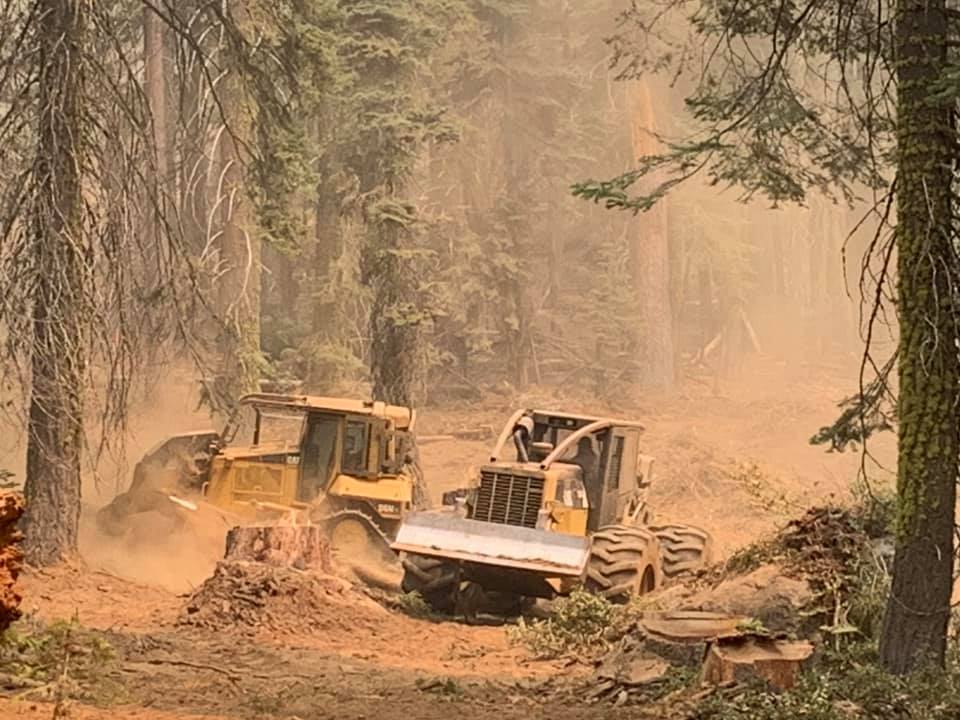News
Ecologist Says the USFS Needs To Get Out of the Way in Wake of Massive Fires
Published
5 years agoon

After nearly three weeks the Creek Fire continues to burn and is now the largest single wildfire in recorded California history at 291,426 Acres according to CAL FIRE. The USFS is still estimating full containment won’t be reached until October 15th.
Madera County Supervisor Tom Wheeler says he knows why the forests are burning at a record rate in the state. “California used to have over 120 Saw Mills to build the roads to and in the Forest, thin, cut , and mill the most renewable resources we have. Trees,” says Wheeler in a text to GV Wire℠. Wheeler says he’s spent the better part of the last 2 decades working through all the necessary red tape to get a biomass plant built in North Fork. Recently, Wheeler signed a 10-year logging contract with the U.S. Forest Service, but still has to spend the next year going through red tape before he can remove one tree.
Recently, Sens. Dianne Feinstein (D-Calif.) and Steve Daines (R-Mont.) introduced the Emergency Wildfire and Public Safety Act. If passed, the bill would create a program to incentivize the collection of woody biomass and help expand processing facilities to make biomass more economically viable.
[rlic_related_post_one]Wheeler says one of the biggest opponents to his biomass project and logging efforts was John Muir Project co-founder Chad Hanson.
So, GV Wire℠ reached out to Hanson to get his perspective on why he doesn’t think logging or biomass is the way to manage forests in California. He believes the problem and solutions are in the hands of regular people.
Madera County Projects

“Before the 3 saw mills shut down here in our area (5 different ones all together) we did not have these great big totally devastating 100,000 acre fires.”–Madera County Supervisor Tom Wheeler
“Let me say that over the 60 plus years I have worked the land here in the foothills and forests I have witnessed many drought years,” says Wheeler. “Before the 3 saw mills shut down here in our area (5 different ones all together) we did not have these great big totally devastating 100,000 acre fires.”
[rlic_related_post_two]Before he became a county supervisor, Wheeler started his career working at the North Fork Saw Mill cutting, burning brush, and logging.
Wheeler says he doesn’t view the environmental movement very kindly. “In the early 90’s the environmental community started using the Spotted Owl endangerment as a excuse to stop logging to save them. We now only have around 20 Saw Mills in California. And guess what? The Spotted Owls are now burning up along with our unmanaged forests,” says Wheeler.
Sierra Nevada Conservancy Work
The Rim Fire started in August of 2013 after a hunter’s illegal fire got out of control. It was named for its proximity to the Rim of the World vista point, a scenic overlook on Highway 120 leading up to Yosemite. The fire burned 257,314 acres.
The Sierra Nevada Conservancy is administering a $28 million NDRC grant for forest resilience efforts where the Rim fire burned including fuels reduction, reforestation, noxious weed abatement, rangeland improvement, and strategic fuel break expansions.
“There has been some public opposition to the project work, but it has not stopped or delayed efforts on the ground,” says Executive Officer Angela Avery in an email to GV Wire℠. She says the SNC board took public comments (Chad Hanson was one) at a June 2018 board meeting that led to a tour with a wide variety of people with differing viewpoints including representatives of the John Muir Project.
“That informational tour was held in May 2019 and no changes were made to the project following the tour,” said Avery.
John Muir Project Perspective
“A lot more dead trees do not burn more intensely. I know that sounds really counterintuitive,” Hanson tells GV Wire℠ over the phone. “What studies are finding is a forest with more dead trees whether they’re recently dead or whether it’s years and years after they died – those forests do not burn more intensely than other forests.”
[rlic_related_post_three]Hanson says other research even shows forests with more dead trees actually burn less intensely. He says when trees die, their small twigs fall and decay in the soil very quickly. Hanson says after that happens, there’s not much on the tree that can carry the flames even though the outer surface of the tree will get scorched.
Hanson co-authored a study on the issue of dying forests in California that he says shows no correlation between the density of dead trees and fire intensity. He says his and other studies keep coming back to the same conclusion. “What they (studies) found is that fire behavior is driven overwhelmingly by weather and climate change,” says Hanson.
Hanson’s Thoughts on Preventing Wildland Fires

“We need to get the US Forest Service out of the commercial logging business and protect our forests.”–Chad Hanson co-founded the John Muir Project in 1996
“We need to get the US Forest Service out of the commercial logging business and protect our forests,” says Hanson. “Logging is making the fires burn more intensely.” He also believes the removal of dead tress is also leading to problems.
“I’m very well aware of the area where the Creek Fire made that 16 mile run (Saturday September 5),” explains Hanson. “That run was through an area that had been heavily post fire logged several years earlier after the French Fire.” He also says areas of the devastating 2018 Camp Fire that burned in the first 6 hours had been heavily logged.
So, his answer to the question of what needs to be done to prevent large wildfires? Two things.
“You’re not going to avoid fires. You’re going to have lightning strikes, but you can certainly stop unplanned human ignitions,” says Hanson. “We need more rangers to prevent unplanned human ignitions during fire season.”
He believes the large sums of money being spent on logging operations would be better spent on fire prevention.
“The other thing I would say in terms of a better way forward is we need to devote our resources to helping homeowners make their homes fire safe,” said Hanson. He thinks residents need to install fire resistant roofing, rain guards, ember proof vents, and provide defensible space pruning within 100 feet of their homes.
Biomass
GV Wire℠ asked Hanson about Senator Dianne Feinstein’s push for more biomass, and the work Wheeler is doing to bring a biomass plant to North Fork.
“What I would say to Feinstein and Wheeler is shame on you,” said Hanson. “Biomass is not stopping fires. In fact, the fires that we have seen burn the most intensely, the most rapidly, have been in areas that were biomass logged.”
Hanson points to a study he co-authored in 2016 that dealt with biomass. “The vast majority of the biomass being pulled out of the forest is literally non combustible to wildland fire.”
You may like
-


Bay Area Restaurants, Wineries File Lawsuit Over Outdoor Dining Ban
-


FBI Alerts Fresno Sheriff to Domestic Terror Threats at State Capitol, No Direct Threats Locally
-


Tulare COVID Vaccine Clinic Turned Away People From San Jose, Oakland
-


Reports: Disney May Relocate Some CA Operations To Florida
-


Bill Led by Borgeas, Caballero Would Deliver $2.6 Billion for CA Small Businesses
-


Thousands of COVID Vaccine Doses Sent Back by Fresno County After ‘Data Logger Issues’














Maya
September 25, 2020 at 8:59 pm
Dear Jim Jakobs,
You did try to balance a controversial issue, fire, and I really appreciate that. Just so you know, the “informational tour” SNC held in May 2019 was attended by about 18 different environmental groups who care deeply about fire safety and who have learned from decades of work in forests – they have been documented. Not one of those groups was pro-biomass. Therefore there is no need to isolate Dr. Chad Hanson here – he is far from alone on these issues.
Sure, they cut snags down from near roadways, but they also removed so much carbon for burning purposes that thousands of living trees were killed in the process. That too has been carefully documented. There would have been little need to conduct “restoration” if they hadn’t decimated the living from the land. It was restoring itself beautifully – luckily several folks were documenting this prior to the destruction.
If you would like to take a look at some of the handiwork done by SNC, supposedly in the name of making us fire -safe, I have hundreds of examples to share with you.
The recent Creek Fire is yet another example of fire running wild through logged lands – and the aerials speak a truth no one can refute. Anyone can say “I’ve never seen fires like this” – but they have to look at the land to see why fires are moving fast – through forests with mostly skinny trees left in place.
Biomass. It burns Everything, whereas fires like the Rim Fire mostly charcoaled the outer bark of trees that became “snags.” A vast majority of the carbon was left, stored, in place. By the way, approx. 80% of the Rim Fire was low or moderate severity, where most of the trees were alive. And the snags were being utilized by countless animals prior to removal.
Taking living, breathing forests and burning them up in biomass plants – which are positioned close to disadvantaged communities – makes very little sense from a climate change standpoint. I am not sure this fact comes through in your piece, but thanks so much for your effort.
Jon Jackson
September 25, 2020 at 9:49 pm
The gentleman chad Hansen is completely full of crap. His so called studies only benefit his agenda. Well his agenda is a direct result of what’s currently going on with these fires. I truly wish that I could have a real debate with him. I hope people don’t believe the crap he’s claiming. Just like the saying goes log it graze it or watch it burn to hell. Well they haven’t logged it the way it needs to be nor grazed it & look at what’s happening. It’s burning to hell. Furthermore it’s got absolutely nothing to do with climate change period. I & others like myself can easily prove that by showing forest land properly logged on the opposite side of a road from land not logged for decades & a fire went through a decimated the unclogged land while the properly logged land had very little damage. Under his idiotic theory climate change didn’t effect the properly logged land. Absolutely ignorant & just plain ole dum as a box of rocks.
Tony montoya
September 26, 2020 at 6:24 am
We need peaple like this to represent our forest .I built roads and logged the shaver,Huntington area in the early 90s till the spotted owl lie started Ltd get back to logging/slash.and burning it works
Judy Johnson
September 26, 2020 at 6:33 am
The last sentence? How can he say that the materials removed for biomass is not combustible to a woodland fire? Has he seen a burn scar just after a good fire went through? I don’t disagree on a few other points but don’t get this belief that there are fuels that don’t burn. If hot enough it all burns and when the fire picks and chooses its sporadic. I lost land in a 2001 fire and it was bizarre what burned entirely and what didn’t.
Jess O'Brien
September 28, 2020 at 10:51 am
Forest Service is designed to provide taxpayer giveaways to logging companies maximize their profits. The taxpayers build the roads, fight the fires, the clean up the mess while the logging companies soak up the profits and walk away. It’s time to put that money into restoring forests and building up the ecosystem so it isn’t so susceptible to mega-fires. We need controlled burns and defensible space not endless, unregulated logging and suburban sprawl.